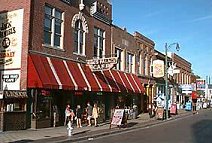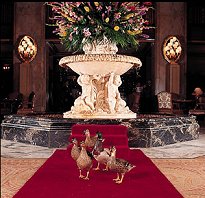The Memphis Brooks Museum of Arts was found in 1916, by Bessie Vance Brooks in memory of her husband, Samuel Hamilton Brooks. The building is  registered as a U.S. National Landmark, and has undergone expansion three times in the past eighty years, to include a rotunda, an auditorium, art classrooms, an orientation theater, a museum store, and an outdoor terrace, overlooking historic Overton Park. The museum was received acclaim for it's collection of Italian Renaissance and Baroque paintings and sculpture. Throughout the galleries can be found a significant collection of European and American paintings, sculpture and decorative arts, drawings, watercolors, prints and photographs. registered as a U.S. National Landmark, and has undergone expansion three times in the past eighty years, to include a rotunda, an auditorium, art classrooms, an orientation theater, a museum store, and an outdoor terrace, overlooking historic Overton Park. The museum was received acclaim for it's collection of Italian Renaissance and Baroque paintings and sculpture. Throughout the galleries can be found a significant collection of European and American paintings, sculpture and decorative arts, drawings, watercolors, prints and photographs.
The first blues song was written on Beale Street in Memphis, by W.C. Handy in 1909. The song, "Boss Crump Blues" was penned as a campaign song for Mayor Crump, and was later published as "The Memphis Blues." The style of  music caught on fast, and Blues bands rapidly filled smoky clubs that popped up along Beale Street. Many of the great Blues men had their starts on Beale, including Muddy Watters, Riley "Blues Boy" (B.B.) King, Alberta Hunter, Memphis Minnie McCoy, Furry Lewis and Albert King. As the depression hit, Beale Street suffered, and some of the older building were lost. In 1966, Beale Street was placed on the National Register of Historic Places, and shortly afterward, renovations began, returning the neighborhood to one of glory. music caught on fast, and Blues bands rapidly filled smoky clubs that popped up along Beale Street. Many of the great Blues men had their starts on Beale, including Muddy Watters, Riley "Blues Boy" (B.B.) King, Alberta Hunter, Memphis Minnie McCoy, Furry Lewis and Albert King. As the depression hit, Beale Street suffered, and some of the older building were lost. In 1966, Beale Street was placed on the National Register of Historic Places, and shortly afterward, renovations began, returning the neighborhood to one of glory.
The National Civil Rights Museum is the first of it's kind in the world that is solely dedicated  to the lessons of the American Civil Rights Movement. Exhibits follow the timeline of events in the struggle of African-Americans from the 1600's, with a strong concentration on the 1950's and 1960's. Some portions of the exhibits are "raw" but display an actual accounting of history. to the lessons of the American Civil Rights Movement. Exhibits follow the timeline of events in the struggle of African-Americans from the 1600's, with a strong concentration on the 1950's and 1960's. Some portions of the exhibits are "raw" but display an actual accounting of history.
The original Peabody Hotel was built by Colonel Robert C. Brinkley in 1869. Right before the grand opening of the hotel, Brinkley received news of the death  of his good friend, George Peabody, and named the hotel after him, in honor. The Peabody hosted a celebrity clientele in it's lavish surroundings. including presidents, movie starts, authors, military dignitaries and plantations owners. They closed for two years in 1923, as building for a larger facility began, on the present-day site. The Peabody has become world famous for the ducks that reside their in a penthouse pond. During the 1930's, general manager Frank Schutt placed his hunting decoys into the fountain in the lobby, and thus a tradition began. Daily, at 11 in the morning a mallard and four hens parade down to the Italian marble fountain in the lobby on a red carpet. At 5 in the afternoon they retreat back to their rooftop haven. of his good friend, George Peabody, and named the hotel after him, in honor. The Peabody hosted a celebrity clientele in it's lavish surroundings. including presidents, movie starts, authors, military dignitaries and plantations owners. They closed for two years in 1923, as building for a larger facility began, on the present-day site. The Peabody has become world famous for the ducks that reside their in a penthouse pond. During the 1930's, general manager Frank Schutt placed his hunting decoys into the fountain in the lobby, and thus a tradition began. Daily, at 11 in the morning a mallard and four hens parade down to the Italian marble fountain in the lobby on a red carpet. At 5 in the afternoon they retreat back to their rooftop haven.
The Hunt-Phelan Home is the oldest, most historic home in Memphis. Built in  1832, the house beckoned the most influential leaders in the state and country, including President Andrew Jackson. When the Civil War broke out, the function of the house quickly changed, as Union General Ulysses S. Grant took over the home and property as his headquarters. For over two years, the home also served as a hospital and hospitality lodge for Union soldiers. The house stood out for more than it's mere beauty - it was loaded with new inventions, including running water, a hot air furnace with a duct system, and the first swimming pool in Memphis. 1832, the house beckoned the most influential leaders in the state and country, including President Andrew Jackson. When the Civil War broke out, the function of the house quickly changed, as Union General Ulysses S. Grant took over the home and property as his headquarters. For over two years, the home also served as a hospital and hospitality lodge for Union soldiers. The house stood out for more than it's mere beauty - it was loaded with new inventions, including running water, a hot air furnace with a duct system, and the first swimming pool in Memphis.
Other area attractions:
Casino entertainment and gambling is available just outside of Memphis, in  Tunica, Mississippi. Nine well known casinos are located here, including Bally's Saloon and Gambling Hall, Fitzgerald's Casino, Gold Strike Casino, Grand Casino, Harrah's Casino, Hollywood Casino, Horseshoe Casino, Sam's Town Gambling Hall, and Sheraton Casino. Big name stars from the entertainment industry appear at the hotels on a regular basis. Tunica, Mississippi. Nine well known casinos are located here, including Bally's Saloon and Gambling Hall, Fitzgerald's Casino, Gold Strike Casino, Grand Casino, Harrah's Casino, Hollywood Casino, Horseshoe Casino, Sam's Town Gambling Hall, and Sheraton Casino. Big name stars from the entertainment industry appear at the hotels on a regular basis.
The Pink Palace was originally designed for Clarence Saunders, founder of  Piggly Wiggly grocery stores. Construction on the dream house began in the early 1920's, but Saunders ran into financial ruin during a legal dispute with the New York Exchange, and had to leave his home unfinished when he declared bankruptcy. The building was eventually given to the city and now serves as Headquarters for the Memphis Museum System. Piggly Wiggly grocery stores. Construction on the dream house began in the early 1920's, but Saunders ran into financial ruin during a legal dispute with the New York Exchange, and had to leave his home unfinished when he declared bankruptcy. The building was eventually given to the city and now serves as Headquarters for the Memphis Museum System. |
|
The Peabody Hotel
Fried Green Tomatoes
|
1 Egg |
|
2 tablespoons milk |
|
1/2 teaspoon salt |
1/4 teaspoon freshly ground pepper |
3/4 cup yellow cornmeal |
1/2 cup sifted all-purpose flour |
3/4 cup vegetable oil |
3 firm green (unripe) tomatoes, cored and cut into 12 slices |
salt and freshly ground black pepper to taste |
sprigs of fresh thyme for garnish (optional) |
Preheat an oven to 200 degrees. In a medium bowl, combine the egg, milk, the 1/2 teaspoon salt and the 1/4 teaspoon pepper and beat until well blended. In another medium bowl, combine the flour and cornmeal. In a heavy, deep skillet over medium-high heat, pour the oil to a depth of 1/2 inch and heat to 350 degrees on a deep-fry thermometer. Dip the tomato slices in the egg mixture to coat evenly. Then dip in the cornmeal mixture, shaking off any excess and wiping your hands to avoid build-up. Fry the tomatoes in 3 batches, turning once, until the coating is crisp and light golden brown on both sides, a total of 3-5 minutes per batch. Working quickly with a slotted spatula, transfer the tomatoes to a baking sheet lined with paper towels to drain. Then transfer the tomatoes to a baking sheet lined with aluminum foil and place in the warm oven until all the batches are ready to serve. Sprinkle with salt and pepper and serve warm. Garnish with thyme sprigs, if desired. |

 registered as a U.S. National Landmark, and has undergone expansion three times in the past eighty years, to include a rotunda, an auditorium, art classrooms, an orientation theater, a museum store, and an outdoor terrace, overlooking historic Overton Park. The museum was received acclaim for it's collection of Italian Renaissance and Baroque paintings and sculpture. Throughout the galleries can be found a significant collection of European and American paintings, sculpture and decorative arts, drawings, watercolors, prints and photographs.
registered as a U.S. National Landmark, and has undergone expansion three times in the past eighty years, to include a rotunda, an auditorium, art classrooms, an orientation theater, a museum store, and an outdoor terrace, overlooking historic Overton Park. The museum was received acclaim for it's collection of Italian Renaissance and Baroque paintings and sculpture. Throughout the galleries can be found a significant collection of European and American paintings, sculpture and decorative arts, drawings, watercolors, prints and photographs.
 music caught on fast, and Blues bands rapidly filled smoky clubs that popped up along Beale Street. Many of the great Blues men had their starts on Beale, including Muddy Watters, Riley "Blues Boy" (B.B.) King, Alberta Hunter, Memphis Minnie McCoy, Furry Lewis and Albert King. As the depression hit, Beale Street suffered, and some of the older building were lost. In 1966, Beale Street was placed on the National Register of Historic Places, and shortly afterward, renovations began, returning the neighborhood to one of glory.
music caught on fast, and Blues bands rapidly filled smoky clubs that popped up along Beale Street. Many of the great Blues men had their starts on Beale, including Muddy Watters, Riley "Blues Boy" (B.B.) King, Alberta Hunter, Memphis Minnie McCoy, Furry Lewis and Albert King. As the depression hit, Beale Street suffered, and some of the older building were lost. In 1966, Beale Street was placed on the National Register of Historic Places, and shortly afterward, renovations began, returning the neighborhood to one of glory.
 of his good friend, George Peabody, and named the hotel after him, in honor. The Peabody hosted a celebrity clientele in it's lavish surroundings. including presidents, movie starts, authors, military dignitaries and plantations owners. They closed for two years in 1923, as building for a larger facility began, on the present-day site. The Peabody has become world famous for the ducks that reside their in a penthouse pond. During the 1930's, general manager Frank Schutt placed his hunting decoys into the fountain in the lobby, and thus a tradition began. Daily, at 11 in the morning a mallard and four hens parade down to the Italian marble fountain in the lobby on a red carpet. At 5 in the afternoon they retreat back to their rooftop haven.
of his good friend, George Peabody, and named the hotel after him, in honor. The Peabody hosted a celebrity clientele in it's lavish surroundings. including presidents, movie starts, authors, military dignitaries and plantations owners. They closed for two years in 1923, as building for a larger facility began, on the present-day site. The Peabody has become world famous for the ducks that reside their in a penthouse pond. During the 1930's, general manager Frank Schutt placed his hunting decoys into the fountain in the lobby, and thus a tradition began. Daily, at 11 in the morning a mallard and four hens parade down to the Italian marble fountain in the lobby on a red carpet. At 5 in the afternoon they retreat back to their rooftop haven.
 1832, the house beckoned the most influential leaders in the state and country, including President Andrew Jackson. When the Civil War broke out, the function of the house quickly changed, as Union General Ulysses S. Grant took over the home and property as his headquarters. For over two years, the home also served as a hospital and hospitality lodge for Union soldiers. The house stood out for more than it's mere beauty - it was loaded with new inventions, including running water, a hot air furnace with a duct system, and the first swimming pool in Memphis.
1832, the house beckoned the most influential leaders in the state and country, including President Andrew Jackson. When the Civil War broke out, the function of the house quickly changed, as Union General Ulysses S. Grant took over the home and property as his headquarters. For over two years, the home also served as a hospital and hospitality lodge for Union soldiers. The house stood out for more than it's mere beauty - it was loaded with new inventions, including running water, a hot air furnace with a duct system, and the first swimming pool in Memphis.
 Tunica, Mississippi. Nine well known casinos are located here, including Bally's Saloon and Gambling Hall, Fitzgerald's Casino, Gold Strike Casino, Grand Casino, Harrah's Casino, Hollywood Casino, Horseshoe Casino, Sam's Town Gambling Hall, and Sheraton Casino. Big name stars from the entertainment industry appear at the hotels on a regular basis.
Tunica, Mississippi. Nine well known casinos are located here, including Bally's Saloon and Gambling Hall, Fitzgerald's Casino, Gold Strike Casino, Grand Casino, Harrah's Casino, Hollywood Casino, Horseshoe Casino, Sam's Town Gambling Hall, and Sheraton Casino. Big name stars from the entertainment industry appear at the hotels on a regular basis.
 Piggly Wiggly grocery stores. Construction on the dream house began in the early 1920's, but Saunders ran into financial ruin during a legal dispute with the New York Exchange, and had to leave his home unfinished when he declared bankruptcy. The building was eventually given to the city and now serves as Headquarters for the Memphis Museum System.
Piggly Wiggly grocery stores. Construction on the dream house began in the early 1920's, but Saunders ran into financial ruin during a legal dispute with the New York Exchange, and had to leave his home unfinished when he declared bankruptcy. The building was eventually given to the city and now serves as Headquarters for the Memphis Museum System.















